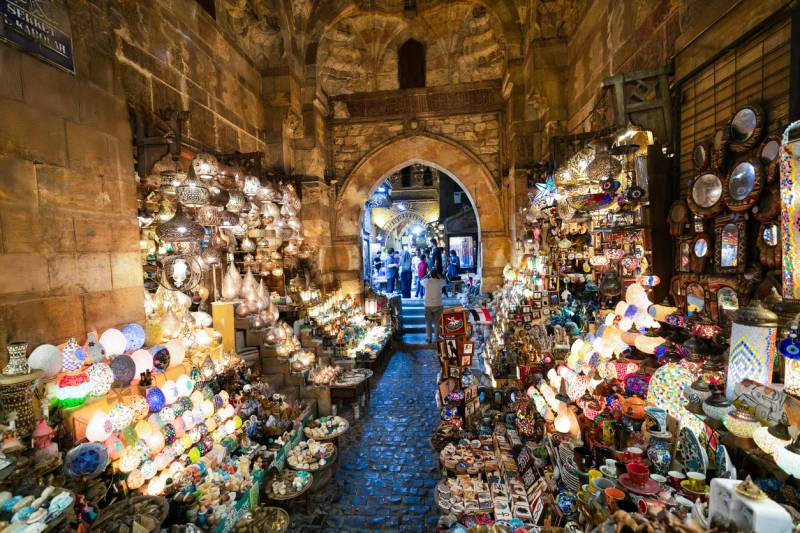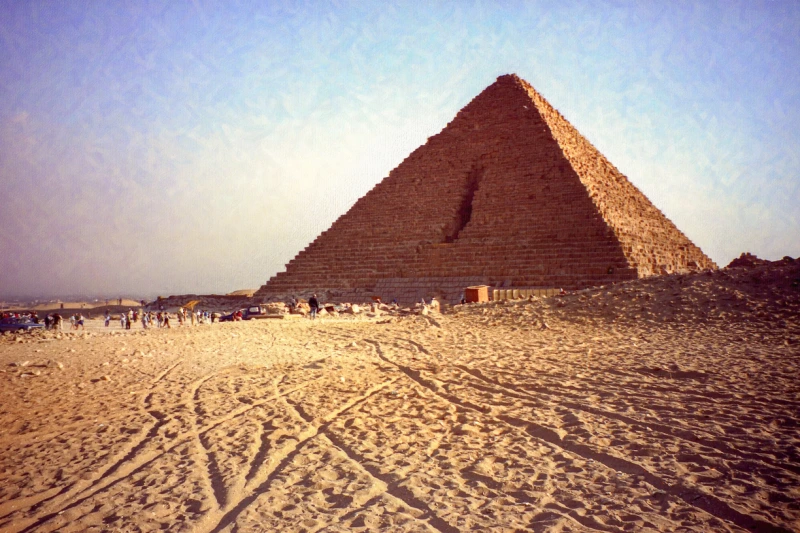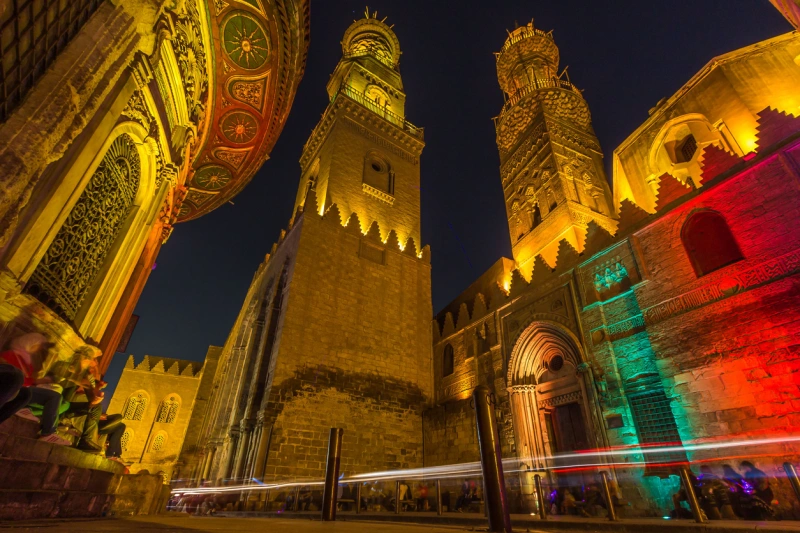Cairo, known as "Um el Donya" or the Mother of the World, Cairo, beyond its iconic Giza Pyramids and bustling markets, reveals a deeper, more intimate side. In the City of the Dead, life and death coexist, while the 9th-century Mosque of Ibn Tulun and the serene Al-Azhar Park reflect Cairo’s spiritual and historical depth. The Gayer-Anderson Museum showcases Egypt's colonial past, and lesser-known treasures like Coptic churches and hidden architectural gems offer a unique, authentic experience. For those willing to explore beyond the usual sights, Cairo provides a rare glimpse into its true soul.
Cairo's attractions bring three iconic spots to mind for most travelers. These familiar destinations showcase Egypt's most recognizable treasures. Yet they barely hint at what this 4,000-year-old metropolis truly has to share.
The usual stops: Pyramids, Museum, and Khan El-Khalili
For many, the Giza Pyramids complex is the first stop in Cairo, with the Great Pyramid of Khufu stealing the show. But what many don't realize is that there are actually nine pyramids in total, all guarded by the enigmatic Great Sphinx. Just a short distance away, the Egyptian Museum is home to over 120,000 incredible artifacts, including the stunning treasures of King Tutankhamun. The buzz is growing for the Grand Egyptian Museum’s full opening on July 3, 2025, when Tut’s entire collection will be displayed together for the first time. No trip to Cairo is complete without getting lost in the vibrant lanes of Khan El-Khalili, the city’s oldest bazaar. Its winding alleys are packed with everything from brassware to spices, and haggling is all part of the fun.
Why do many visitors miss the deeper layers?
Many tourists try to squeeze all three sites into one day, barely scratching the surface. As one local guide puts it, “Most tourists visit the Pyramids, the Egyptian Museum, and maybe the Khan El Khalili market, but most skip Cairo's old town.”
That hurried pace leaves little room for discovery. Beneath Cairo’s better-known facade lies a city full of hidden gems—quiet mosques, ancient alleyways, and stories that unfold only for those willing to explore beyond the usual trail.

While the Great Pyramids cast their magnificent shadows across the centuries, Cairo's outskirts harbor archaeological treasures known only to the most dedicated explorers. These secluded monuments, despite housing some of Egypt's most extraordinary ancient structures, remain blissfully free from tourist throngs, offering visitors an intimate communion with Cairo's storied past.
Saqqara, just south of Cairo, is Egypt’s oldest and largest archaeological site. While most come to see the Step Pyramid of Djoser, its lesser-known tombs hold the real surprises.
Recent digs uncovered the tomb of Queen Neith—previously unknown—and over 300 coffins and 100 mummies, reshaping what historians knew about New Kingdom burials here.
One standout discovery is the tomb of Tetinebefou, a royal physician from 4,100 years ago. His titles, including “chief dentist” and “conjurer of the goddess Serqet,” offer a rare glimpse into ancient Egypt’s medical world.
Just 90 minutes from Cairo, Dahshur’s ancient pyramids offer a peaceful escape from the tourist crowds—and a rare chance to explore Egypt’s architectural evolution up close.
Built by Pharaoh Sneferu around 2575 BCE, the Bent Pyramid stands out with its unusual shape: it starts at a steep angle, then shifts halfway up due to structural issues, making it a frozen moment of ancient trial and error. It’s also the only Old Kingdom pyramid with two entrances.
Not far off is the Red Pyramid, Egypt’s first true smooth-sided pyramid. With its reddish limestone and towering 105-meter height, it invites visitors to explore its quiet, steep passageways without the crowds, offering an intimate encounter with ancient genius.
The Sultan al-Ghuri Complex, tucked along al-Mu'izz Street in medieval Cairo, is a hidden architectural gem. Built between 1503 and 1505, the complex features two buildings across from each other: one with the Sultan’s mausoleum, a Sufi lodge, a public fountain, and a Quranic school, and the other with a mosque and madrasa. Once, a wooden roof covered the entire street, sheltering a vibrant textile market. Inside the mausoleum, intricate marble details and a calligraphic frieze stand out, but the tomb remains empty as Sultan al-Ghuri’s body was never recovered after his death in 1516. This quiet site offers a more intimate way to experience Cairo’s rich history, away from the crowds.

Beyond Cairo's celebrated monuments lies the authentic heartbeat of the city, pulsating in secluded corners cherished principally by its inhabitants. These genuine sanctuaries offer travelers unvarnished glimpses into Cairo's living cultural tapestry, far removed from the well-trodden tourist circuits where authenticity often diminishes beneath commercial demands.
1. Beit El Sehemy: A preserved Ottoman home
Nestled discreetly within al-Darb al-Asfar Lane, just off al-Muizz Street, Beit El Sehemy is an overlooked Ottoman-era gem. Built in 1648 and expanded in 1796, it was named after its final resident, Shaykh Muhammad Amin al-Suhaymi, an Ottoman scholar from Al-Azhar. The house showcases clever Islamic design features, like an angled entrance for privacy and ornate mashrabiya screens allowing women to observe the outside world unseen. Inside, the layout reflects social customs, with separate areas for men and women. Spanning three stories, it offers a glimpse into the past with marble mosaics, a central courtyard, a Turkish bath, and even a birthing chair.
At night, Al-Muizz Street reveals a magical side of Cairo that many miss during the day. Established in 969 CE, it’s home to the richest collection of medieval Islamic architecture, but its true beauty shines after sunset. Thoughtful lighting illuminates ancient mosques and palaces, turning the street into a dreamy open-air gallery. Evening strolls offer tasty Egyptian street food, like falafel and shawarma, alongside mint tea. Local artisans display unique crafts, and the street comes alive with music and dance during cultural celebrations like Moulid, offering a lively celebration of Egypt’s heritage.
3. Local music at El Mastaba Center
El Mastaba Center for Egyptian Folk Music, founded in 2000 by ethnomusicologist Zakaria Ibrahim, offers an authentic cultural experience by preserving Egypt's folk music traditions. It showcases a wide variety of styles, from Sufi and Nubian music to regional performances like Simeimeya and Zar. What makes El Mastaba unique is its focus on returning these traditions to their original communities, ensuring their future. Every Thursday at El Dammah Theater, visitors can enjoy live, authentic music that goes beyond typical tourist attractions, offering a true connection to Egypt’s musical heritage.

Q1. Is it safe for tourists to explore Cairo on foot?
Yes, walking in popular areas like the Citadel and Khan El-Khalili is generally safe, though a guidebook can help with planning.
Q2. What are some hidden historic sites in Cairo that most tourists miss?
Lesser-known sites include Saqqara's tombs, the Red and Bent Pyramids of Dahshur, and the Sultan Al-Ghuri Complex, offering a more peaceful experience of Cairo's history.
Q3. Are there any unique cultural experiences in Cairo that locals enjoy?
Locals enjoy visiting Beit El Sehemy, exploring Al-Muizz Street at night, and enjoying folk music performances at El Mastaba Center.
Q4. What's an extraordinary spiritual site to visit in Cairo?
The Cave Church, or Monastery of Saint Simon the Tanner, carved into the Mokattam Hills, is the largest church in the Middle East and offers a unique spiritual experience.
Q5. When is the best time to visit Al-Muizz Street in Cairo?
Al-Muizz Street is most lively at night, with its medieval architecture illuminated, offering a chance to enjoy local food, shop for souvenirs, and experience cultural events.
Cairo is a city full of contrasts, where ancient history blends seamlessly with modern life, far beyond the shadows of the pyramids. Many visitors stick to the familiar sights like Giza, the Egyptian Museum, and Khan El-Khalili, missing out on the true essence of this 4,000-year-old city. While the Great Pyramid is definitely a must-see, Cairo’s heart beats in the hidden corners and authentic experiences that are waiting to be discovered. It’s in these lesser-known places where the magic of Egypt’s capital really comes alive, earning it the nickname “Mother of the World.”